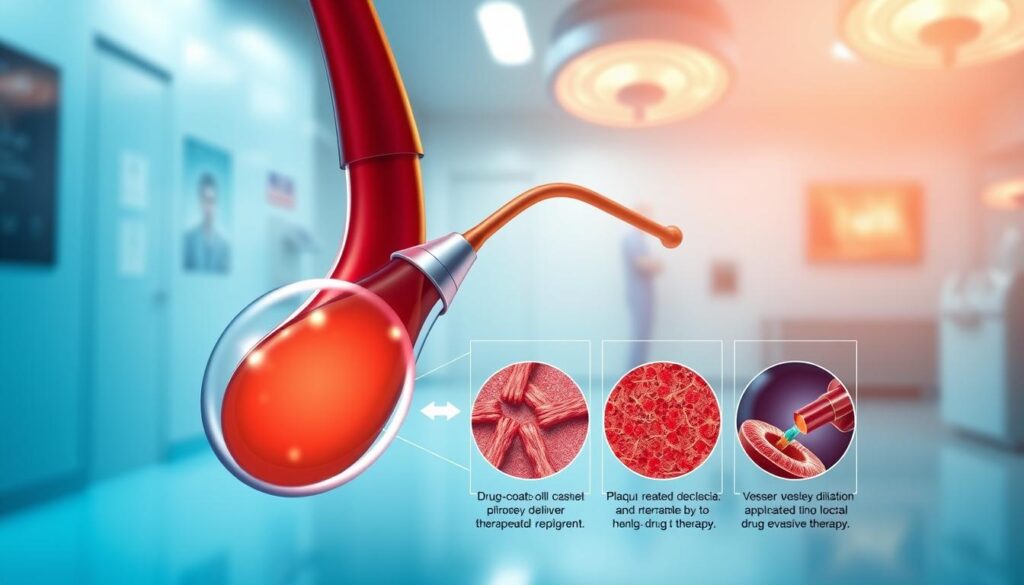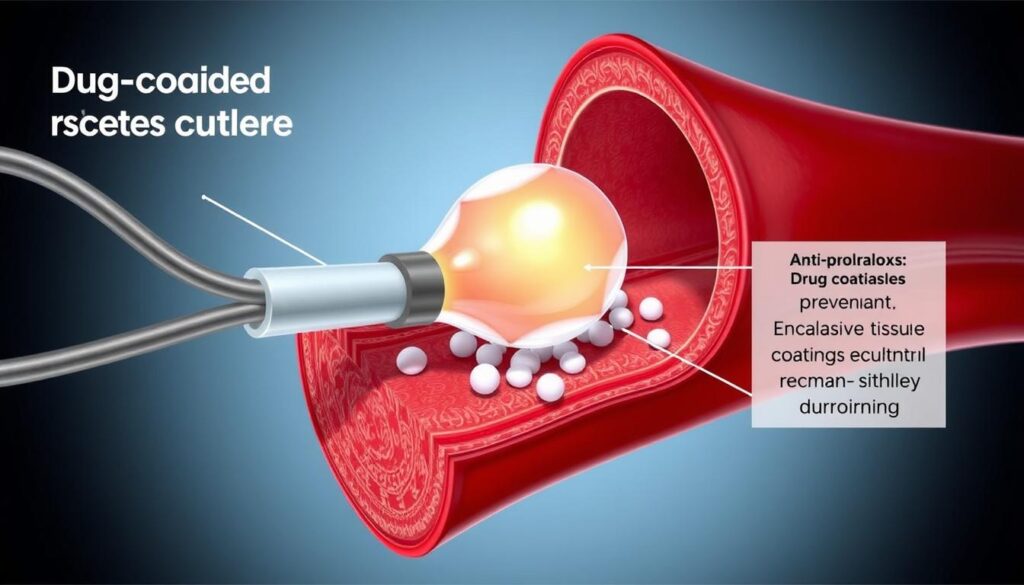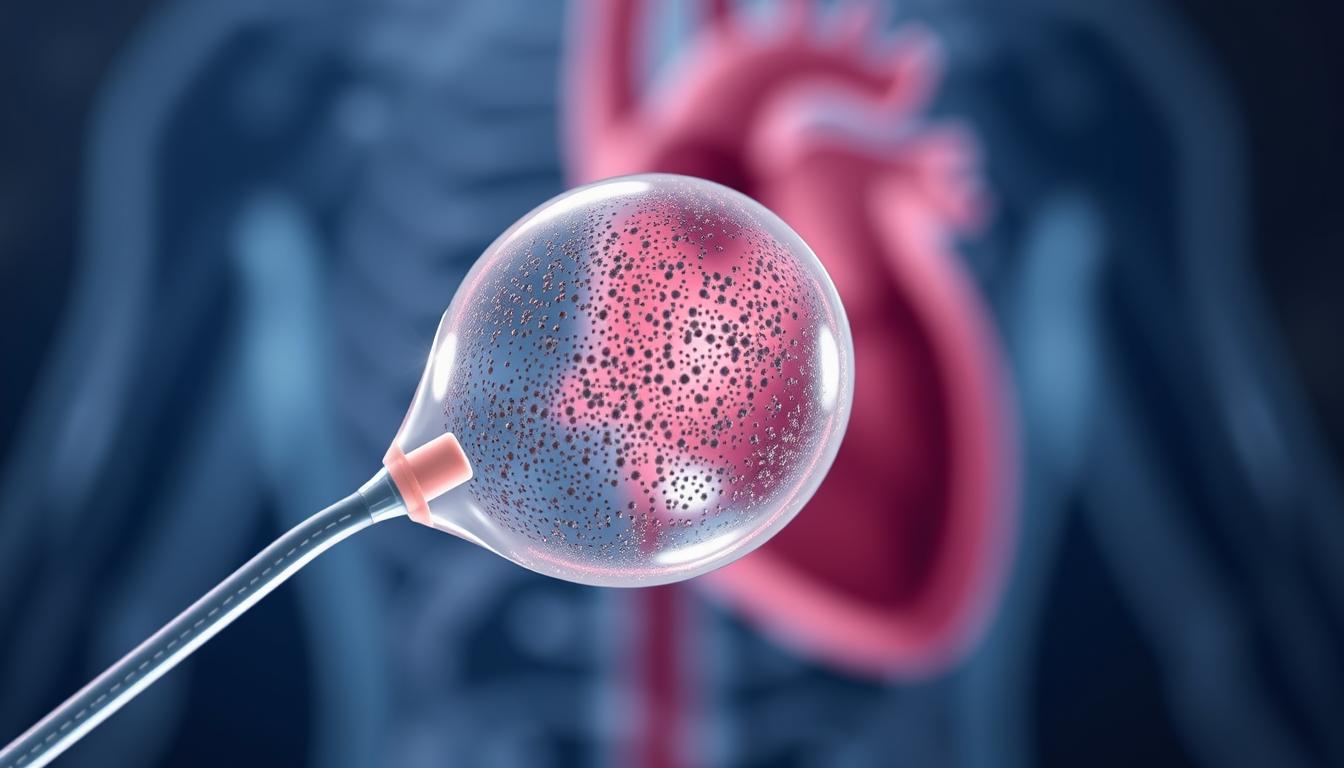In the United States, coronary artery disease (CAD) is a big health problem. Drug-coated balloons (DCBs) are a new way to treat heart issues without surgery1. These devices are made to fix the old problems of metal stents, giving patients a better treatment option1.
Doctors have found that drug-coated balloons are a smart choice instead of old stenting methods. They release medicine right where it’s needed, avoiding the risks of metal implants2.
More and more people worldwide are getting coronary artery disease. So, new treatments like DCBs are very important2. They could change how we treat heart problems, especially for those with complex health issues.
Key Takeaways
- DCBs offer a non-invasive alternative to traditional stent treatments
- Targeted drug delivery reduces potential complications
- Innovative technology addresses limitations of metallic stents
- Potential to improve patient outcomes in coronary artery disease treatment
- Represents a significant advancement in cardiovascular medical technology
Understanding Coronary Artery Disease and Current Treatment Challenges
Coronary artery disease (CAD) is a major health issue affecting millions globally. The silent epidemic of heart diseases needs new treatments and management2. It’s the top cause of death worldwide, especially in the Asia-Pacific region2.
The Escalating Global Health Burden
Dealing with coronary artery disease is a big challenge for healthcare today. This condition puts a lot of pressure on medical systems everywhere. Here are some important facts about this health issue:
- 20-30% of patients with symptomatic CAD experience small vessel disease3
- Most patients are male (82%) and average 65 years old3
- About 37% of patients studied have diabetes3
Limitations of Traditional Stent Treatments
Traditional stent treatments have big limitations for coronary artery disease. In-stent restenosis (ISR) happens in 10-15% of patients with stents4. Women are at higher risk because of smaller arteries, making treatment harder4.
The Need for Alternative Solutions
Doctors are looking for new ways to treat coronary artery disease. Drug-coated balloons (DCBs) are seen as a good option. They might improve patient results. Studies show they work as well as, or better than, traditional stents3.
Drug-Coated Balloons: The Future of Non-Invasive Heart Treatments
Drug-coated balloon technology is changing how we treat heart disease. It uses a leave-nothing-behind approach to treat coronary artery disease5. Doctors can now use balloons to deliver drugs directly to blockages, making treatments more precise.
Two main types of drug-coated balloons are making a big difference in heart care: paclitaxel-eluting and sirolimus-eluting balloons. These devices are better than old stenting methods6:
- Less chance of stent problems
- Need for fewer medicines after treatment
- Less invasive treatment
- Drugs are delivered right to the problem area
Studies show drug-coated balloons work really well. For example, the PACCOCATH-ISR trial found:
| Metric | Drug-Coated Balloon | Standard Angioplasty |
|---|---|---|
| Late Luminal Loss | 0.03 mm | 0.74 mm |
| Binary Restenosis Rates | 5% | 43% |
| Target Lesion Revascularization | 0% | 23% |
This technology is a big step forward in heart care. It promises better results and fewer side effects5.
How Drug-Coated Balloon Technology Works
Drug-coated balloon (DCB) technology is a big step forward in heart care. It uses a smart way to deliver drugs during balloon angioplasty. This method is non-invasive and treats heart disease by focusing on the problem areas.
Mechanism of Drug Delivery
The DCB method is unique because it precisely delivers drugs. When the balloon is inflated, it spreads the drug on the artery wall. This creates a strong effect right where it’s needed1.
This targeted method reduces the drug’s impact on the whole body. It makes the treatment more effective.
Types of Drugs Used in DCBs
DCBs use special drugs to stop the artery from narrowing:
- Paclitaxel: This is the main drug used in DCBs.
- Sirolimus: It’s another drug that stops the artery from narrowing.
- Everolimus: This drug is also used to treat the artery wall.
Technical Aspects of DCB Procedures
For DCB treatment to work well, careful steps are needed. It’s important to prepare the area well before treatment. This includes:
- Using a balloon that’s the right size for the artery.
- Using special balloons to cut or score the artery for tough spots.
- Thinking about adding treatments like atherectomy for hard areas.
Studies show DCB technology works well. In 69% of patients, the artery got bigger after treatment7. More than half of the treated areas stayed open for over a year, with 88% still open after a long time1.
DCB technology is a big leap in heart care. It delivers drugs precisely without using permanent implants.
Research keeps showing how promising DCB technology is. It’s changing how we treat heart disease.
Benefits of Drug-Coated Balloon Treatment
Drug-coated balloons (DCBs) are a new way to fight coronary artery disease. They offer big advantages over old stenting methods. DCBs use a “leave nothing behind” approach, which is less invasive and cuts down on metal in arteries8.
Key benefits of drug-coated balloon treatment include:
- Reduced metal burden in coronary arteries
- Shorter dual antiplatelet therapy (DAPT) duration
- Lower risk of late stent-associated events
- Preservation of future treatment options
Clinical studies show DCB technology works well. The BELLO study found lower restenosis rates and fewer bad heart events than traditional stents8. DCBs also do great in tough cases where stents might fail5.

| Metric | DCB Performance | Traditional Treatment |
|---|---|---|
| Late Luminal Loss | 0.03 mm | 0.74 mm |
| Restenosis Rates | 5% | 43% |
| Target Lesion Revascularization | 0% | 23% |
DCBs need less DAPT, which is good for those at high bleeding risk. This means fewer complications for patients5. This new method is a big step forward in treating the heart without being too invasive.
DCBs provide a promising alternative to traditional stenting, with demonstrated effectiveness in complex coronary interventions.
Clinical Applications in Small Vessel Disease
Small vessel disease is a big challenge in heart treatments, affecting up to 30% of patients9. Drug-coated balloons (DCBs) are seen as a good solution for these tough cases.
Treatment Outcomes in Small Vessels
Recent studies show DCBs work well for small vessel disease. They compared DCBs with traditional drug-eluting stents (DES) and found good results:
- The BASKET-SMALL 2 trial found comparable major adverse cardiac events (MACE) rates for DCB and DES9
- RESTORE SVD trial showed target lesion failure of 4.4% for DCB versus 2.6% for DES9
- PICCOLETO II study found significantly lower in-lesion late lumen loss with DCB9
Comparison with Traditional Stenting
DCBs have many benefits over traditional stents. They have similar results but lower risk of blood clots9. Also, patients on DCBs usually need less time on blood thinners, just one month9.
Patient Selection Criteria
Choosing the right patients for DCB treatment is key. Doctors should look at:
- Vessel diameter
- Lesion complexity
- Patient’s bleeding risk
- Previous intervention history
The European Society of Cardiology guidelines recommend DCBs for small vessel treatments10.
Treatment of In-Stent Restenosis with DCBs
In-stent restenosis (ISR) is a big problem in heart care. It happens in 5-10% of all heart procedures11. Drug-coated balloons (DCBs) are seen as a good solution for this issue12.

Studies show DCBs work well for ISR. The BELLO trial found DCBs cut down late lumen loss more than drug-eluting stents12. At 12 months, DCB patients had fewer heart problems:
- DCB group: 14.4% event rate
- Drug-eluting stent group: 30.4% event rate12
DCB technology has changed how we treat restenosis. Studies show DCBs are good for tough cases of ISR12.
Using DCBs for ISR has many benefits:
- Lower need for more procedures
- Less invasive
- Better long-term results for patients11
The European Society of Cardiology says DCBs are a Class I indication for ISR. This shows how important they are12.
Large Vessel Applications and Outcomes
Drug-coated balloons (DCBs) are a new hope for treating large vessel disease. They offer fresh ways to tackle tough coronary artery problems13.
Clinical Trial Insights
Recent studies show DCBs work well in big arteries. A big trial looked at 288 patients with big artery blockages. It compared DCBs with drug-eluting stents13.
- 9-month late lumen loss was −0.19±0.49 mm for DCB
- 12-month major adverse cardiac events were similar between groups
- DCB showed promising clinical outcomes in large vessel interventions14
Long-Term Safety Evaluation
Long-term safety data for DCBs in big arteries looks good. This method might be better for complex heart problems14.
| Metric | DCB Performance |
|---|---|
| 12-month MACCE Rate | 4% |
| Late Luminal Loss | 0.03 ± 0.48 mm |
Patient Selection Guidelines
Choosing the right patients for DCB treatment is key. Consider:
- Vessel diameter compatibility
- Lesion length
- Patient cardiovascular risk profile14
The world of DCB technology is growing. It’s opening up new options for treating big vessel disease. This means less invasive treatments than traditional stenting13.
Future Developments and Research Directions
The world of drug-coated balloons (DCBs) is growing fast. New ideas in DCB technology could change how we treat heart problems. Scientists are looking into new drugs like sirolimus and everolimus. These could give patients more treatment choices15.
Studies are comparing different drugs in DCBs. For example, a study compared sirolimus-coated and paclitaxel-coated balloons16. This could lead to better treatments for patients.
Researchers want to use DCBs in more places in the body. They think DCBs could work in the kidneys, in children’s hearts, and for complex problems in stents15. They’re working hard to make sure these treatments are safe and work well17.
Clinical trials are helping to make treatments more tailored to each patient. Scientists are looking at the right amount of drug, the best balloon design, and who should get these treatments16. They aim to make treatments that are less invasive and have fewer side effects15.
The future of DCBs is exciting. There could be better ways to deliver drugs and more uses for them. As research goes on, these new technologies might change how we treat heart problems. They could offer treatments that are more precise and suited to each patient’s needs17.
FAQ
What are drug-coated balloons (DCBs) and how do they differ from traditional stents?
What types of drugs are used in drug-coated balloons?
In what clinical scenarios are drug-coated balloons most effective?
What are the key advantages of drug-coated balloon treatment?
Are drug-coated balloons suitable for all patients with coronary artery disease?
How do drug-coated balloons work to prevent restenosis?
What is the future outlook for drug-coated balloon technology?
How long has drug-coated balloon technology been in use?
What are the potential risks associated with drug-coated balloon treatment?
Source Links
- A 2024 scientific update on the clinical performance of drug-coated balloons – https://pmc.ncbi.nlm.nih.gov/articles/PMC10900242/
- Drug-coated balloon treatment in coronary artery disease: Recommendations from an Asia-Pacific Consensus Group – https://pmc.ncbi.nlm.nih.gov/articles/PMC8105061/
- Drug-Coated Balloon-Only Percutaneous Coronary Intervention for the Treatment of De Novo Coronary Artery Disease: A Systematic Review – https://pmc.ncbi.nlm.nih.gov/articles/PMC6251821/
- UPMC and AGENT™ Drug-Coated Balloon for In-Stent Restenosis | UPMC Physician Resources – https://www.upmcphysicianresources.com/news/022725-dcb
- The current status of drug-coated balloons in percutaneous coronary and peripheral interventions – https://eurointervention.pcronline.com/article/the-current-status-of-drug-coated-balloons-in-percutaneous-coronary-and-peripheral-interventions
- Coronary Drug-Coated Balloons – American College of Cardiology – https://www.acc.org/latest-in-cardiology/articles/2016/07/26/08/21/coronary-drug-coated-balloons
- Clinical expert consensus document on drug-coated balloon for coronary artery disease from the Japanese Association of Cardiovascular Intervention and Therapeutics – https://pmc.ncbi.nlm.nih.gov/articles/PMC10020262/
- Frontiers | Research progress of drug eluting balloon in arterial circulatory system – https://www.frontiersin.org/journals/cardiovascular-medicine/articles/10.3389/fcvm.2024.1287852/full
- Drug-coated Balloons for Small Coronary Disease—A Literature Review – https://pmc.ncbi.nlm.nih.gov/articles/PMC8516758/
- PDF – https://jotci.org/wp-content/uploads/articles_xml/2595-4350-jotci-28-eA202012/2595-4350-jotci-28-eA202012.pdf
- Management of in-stent restenosis | EuroIntervention – https://eurointervention.pcronline.com/article/management-of-in-stent-restenosis
- Coronary Drug-Coated Balloons for De Novo and In-Stent Restenosis Indications – https://pmc.ncbi.nlm.nih.gov/articles/PMC11308150/
- Novel application of drug-coated balloons in coronary heart disease: A narrative review – https://pmc.ncbi.nlm.nih.gov/articles/PMC10017483/
- Application of Drug‐Coated Balloons in Complex High Risk and Indicated Percutaneous Coronary Interventions – https://pmc.ncbi.nlm.nih.gov/articles/PMC11788978/
- Research progress of drug eluting balloon in arterial circulatory system – https://pmc.ncbi.nlm.nih.gov/articles/PMC11005962/
- Contemporary Use of Drug-Coated Balloons for Coronary Angioplasty: A Comprehensive Review – https://www.mdpi.com/2077-0383/13/20/6243
- PDF – https://eurointervention.pcronline.com/article/the-current-status-of-drug-coated-balloons-in-percutaneous-coronary-and-peripheral-interventions/pdf




